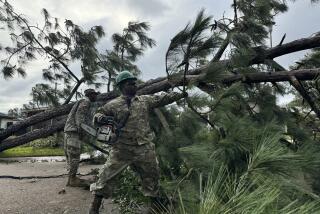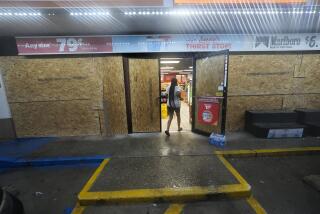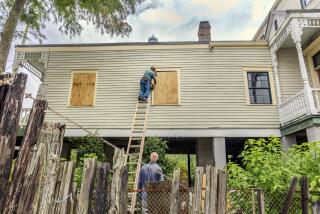Pilots See It All From the Air
NEW ORLEANS — From 1,000 feet up, it looked like a scar on the airport runway -- a jagged line snaking across the slick asphalt at New Orleans Lakefront Airport.
Then, as a relief helicopter dropped down from leaden skies Thursday, the runway scene came into focus: a twisting column of refugees who had been plucked from rooftops across the flooded city.
For the past two days, helicopter crews have been rescuing people stranded on rooftops and dropping them off on the runways of the partially flooded airport on the south shore of overflowing Lake Pontchartrain. It is one of the few clear, relatively dry sites available in a city that is more than 80% underwater.
Cleve Paget, a pilot working for an emergency rescue agency, swooped down on the refugees in a white Bell LongRanger Four helicopter, loaded with 250 pounds of bottled water and fresh bananas. No one knew how long the about 200 refugees would have to wait for military Chinook helicopters to ferry them to a collection point, where they were told they would board buses bound for Houston.
“I don’t care where I’m going, as long as I’m out of that house,” said Edith Scott, 76, a slight, spare woman who clutched a handbag and a pair of white sneakers as she waited in line on the runway.
She said she had been trapped since Sunday in her two-story home downtown before a U.S. Coast Guard helicopter rescued her from her rooftop Thursday. Water had crested over her kitchen cabinets, she said, and she had survived upstairs, literally, on bread and water.
Scott and her soggy, dispirited fellow refugees were one stop on a remarkable journey Thursday for Paget, himself a refugee who fled his home just west of New Orleans on Sunday. His relief flight for Acadian Ambulance Service afforded him a front-row seat on one of the worst natural disasters in American history.
“The TV pictures don’t do it justice. You have to be up here to really appreciate the magnitude of this thing,” Paget, 40, a former U.S. Special Forces sergeant, said as he banked the helicopter over a rupture in a levee just south of the lake, where a seemingly endless expanse of black, oily water stretched to the horizon.
Paget was one of several pilots in the air Thursday for Acadian Ambulance, based at Lafayette Regional Airport in Lafayette, about 100 miles northwest of New Orleans. He and his helicopter had been donated by his employer, which provides aircraft services to the oil industry.
On the first of two flights Thursday, Paget swung low over his abandoned three-story condominium in Metairie on the western edge of New Orleans. He got close enough to see that it was not underwater, and that the only noticeable damage was a broken window.
Paget’s second route had taken him over the Superdome, with its shattered, peeling roof, perched like a castle surrounded by a moat. Thousands of refugees surged around the edges of the round colossus, desperate to leave but unable to see rows of buses parked several blocks away.
More refugees stood bunched on a freeway overpass, tiny figures milling at the edge of the highway. Others left little wakes in the water as they trudged forward, some pushing supermarket carts loaded with possessions. A few boats floated past.
Along Interstate 10, cars and trucks lay abandoned next to tractor-trailers that had pitched on their sides. Along the south shore of Lake Pontchartrain, dozens of yachts and pleasure boats lay stacked atop one another by the winds of Hurricane Katrina. To the west, near Live Oak Manor, thousands of hardwoods had been felled, row upon row across the low brown landscape.
As Paget approached the refugees at the airport, he stared at the wreckage of private planes that had been tossed across the runway, and at the airport hangars whose roofs had been sheared off. He landed on the tarmac, where he was greeted by Corey Breaux, a fireman who had ridden out the hurricane inside an airport hangar and was now assisting the runway refugees.
“We need anything you can give us,” Breaux told Paget as he unloaded the water and bananas. “We’re running short of everything.”
Breaux was also a refugee, having fled his home in New Orleans over the weekend. He said he spent Wednesday night on the tarmac with nearly 200 refugees, who were taken away by Chinooks Thursday morning and replaced by more refugees rescued from rooftops during the day.
Among them was Tashilea Journee, 34, a nurse technician at Methodist Hospital in the city. She said she had taken refuge in the hospital, joined by her husband, Jimmie, and her daughters, ages 10 and 14. Now the four of them had been drenched by a fierce afternoon thunderstorm, just after being dropped off by a Coast Guard helicopter that had taken them from the hospital roof.
Journee had a message for her mother, Elaine Diaz, whom she has not seen since the two were separated during the height of the hurricane Monday: “I’m OK. Your grandchildren are OK.”
Able-bodied refugees normally are not the focus of Acadian, which specializes in medical evacuations. The service evacuated 700 hospital patients before the hurricane struck and between 1,800 and 2,500 since Monday, said company chairman Richard Zuschlag.
By the time Paget maneuvered his helicopter back to the Acadian base at the Lafayette Airport just before dusk Thursday, other pilots had just landed with delicate cargos -- 13 premature babies taken from neonatal intensive care units at seven city hospitals threatened by floodwaters, looters and faltering generators. More than 40 have been evacuated since Tuesday.
Nurses accompanying the babies carried them three to a cot, some attached to oxygen canisters via tiny tubes inserted into their noses. They called out their names -- “Baby Davis!” “Baby Wilson!” “Baby Johnson” -- as medical technicians directed them to ambulances bound for hospitals in Lafayette, Lake Charles and other Louisiana cities. On the ankle of each infant was a tiny identification bracelet.
Their parents did not accompany the babies, many of whom were just a few days old. Most of the parents were still at the downtown hospitals awaiting evacuation, said Angela W. Smith, a nurse practitioner who had flown in from the city.
“We’ll get them all reunited once this is all over,” Smith said. “But right now, we’ve got to save these babies.”
More to Read
Sign up for Essential California
The most important California stories and recommendations in your inbox every morning.
You may occasionally receive promotional content from the Los Angeles Times.











